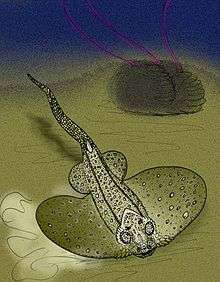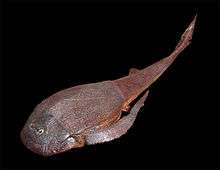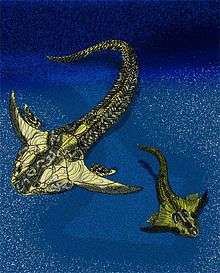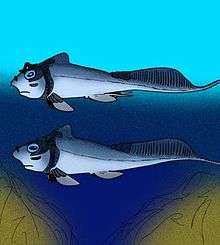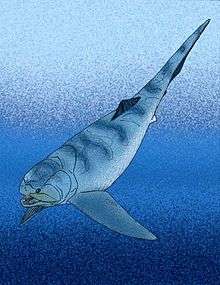Aspidichthys
Aspidichthys ("Shield fish") is a genus of large, distinctively tuberculated arthrodire placoderm of uncertain affinities from Upper Devonian marine strata in the Eastern United States and Europe.[1]
| Aspidichthys Temporal range: Frasnian | |
|---|---|
| dorsal shield | |
| Scientific classification | |
| Kingdom: | |
| Phylum: | |
| Subphylum: | |
| Class: | |
| Order: | |
| (unranked): | |
| Genus: | Aspidichthys Newberry, 1873 |
| Type species | |
| Aspidichthys clavatus Newberry, 1873 | |
| Species | |
| |
| Synonyms | |
| |
Anatomy
The dermal surfaces of the thick bones are decorated with an irregular arrangement of large, rounded tubercles. Some specimens may display patterns of "imperfectly concentric rows."[1] The long median dorsal plate is subrectangular in shape, and is gently bent along the midline, which tends to have a corresponding low ridge, and a posteriorly placed carinal process on the dorsal surface.[1] In 1938, Schmidt made a restoration of A. ingens as a large-bodied, small-headed arthrodire with tremendous orbits after the now-lost holotype of that species.
Taxonomy
The taxonomic relationships of the genus remain uncertain.[1] Miles, 1973, suggested the genus was related to the Euleptaspidae, though, this is disproved through noting the drastically different proportions of the nuchal and median dorsal plates.[1] Schmidt's restoration of the animal as having a large body and a small head has led some paleontologists[2] to suspect a relationship with the holonematids. However, this relationship is also doubtful, as the holonematids' median dorsal plates differ from those of Aspidichthys by the former being more narrower, having a low keel, and having no carinal process.
Species
A. clavatus is the type species, and is known from distinctive fragments found in the Frasnian-aged Huron and Olentangy Shales of Ohio. It has a "gently folded" median dorsal plate, and has a low crest placed on the posterior end of the median dorsal's midline. The length of the median dorsal ranges from 39 to 44 centimeters.[1]
A. ingens is a second, tremendously large species, known from Frasnian-aged strata of Rheinland, Germany, the Holy Cross Mountains of Poland, Moroccan strata, and possibly from Iran.[1] The 80 centimeter-long nuchal plate is much more steeply-folded than that of A. clavatus. According to Dennison 1978, the huge size of the nuchal plate makes A. ingens "the largest arthrodire in Europe."[1]
References
- Denison, Robert (1978). PlacodermiVolume 2 of Handbook of Paleoichthyology. Stuttgart New York: Gustav Fischer Verlag. pp. 102–104. ISBN 978-0-89574-027-4.
- "A relationship to Holonematidae has been suggested by several paleontologists, and is possible in spite of some important differences."
